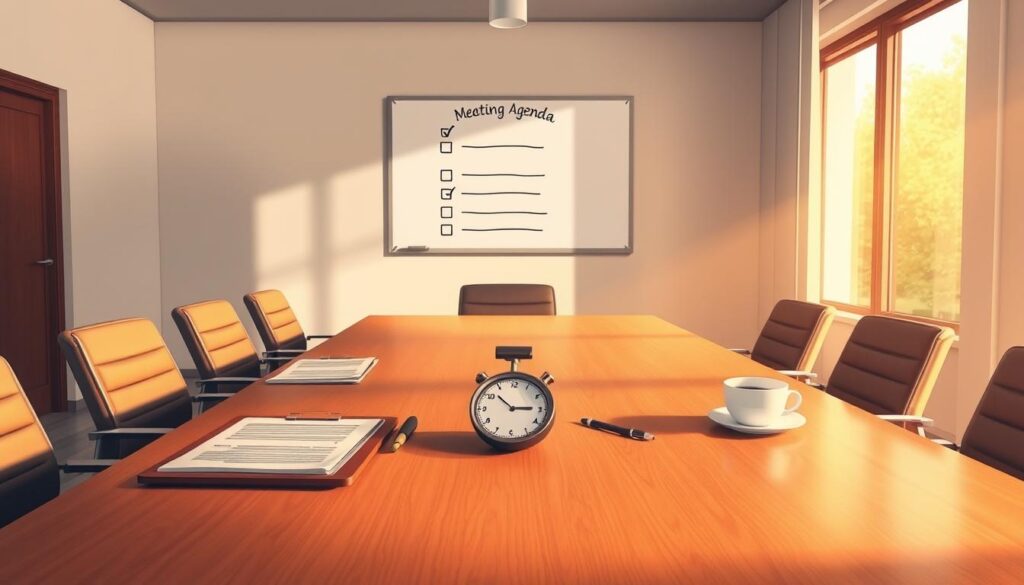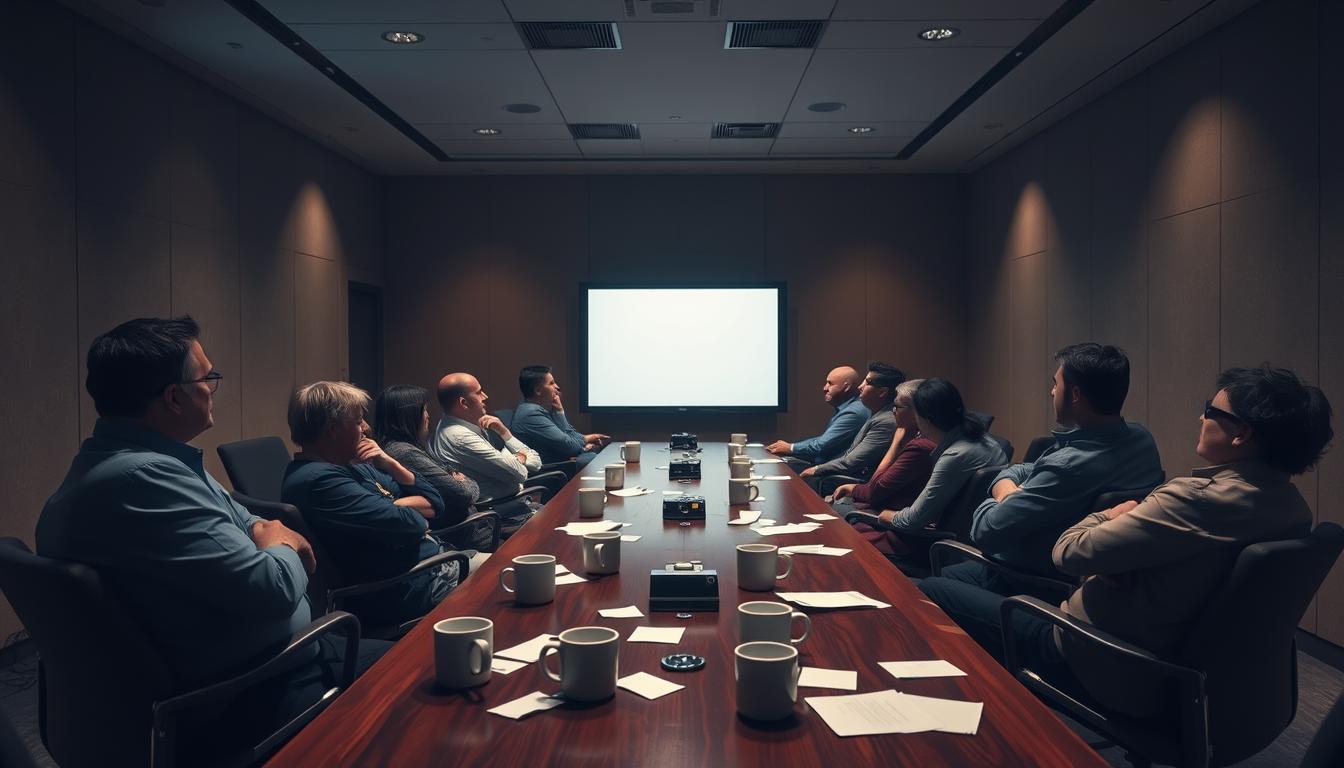A clear agenda is key for good meetings. When there’s no meeting agenda, discussions can go off track. Over half of meetings happen without a clear plan, making them less useful. We’ll explore how lacking agendas affect meetings and show why they’re essential for smooth talks.
The Importance of a Meeting Agenda
A good meeting agenda is key to having productive talks. It sets a clear path for everyone. It outlines everyone’s roles, making it easier for people to engage.
Setting Clear Expectations
It’s important to know what a meeting will involve. A detailed agenda shows what will be discussed and the goals. This way, everyone can come prepared to add value. Knowing what’s ahead helps achieve the meeting’s aims.
Focus and Direction for Discussions
An agenda keeps the meeting focused. It helps keep the conversation on the right path, avoiding off-topic talks. This makes sure all important points are covered. Well-planned agendas lead to productive discussions and clear next steps.
Clarity & Direction in Meetings
Effective meetings depend on clear and well-defined goals. Setting these goals before the meeting helps guide the conversation. This way, everyone knows why they’re there and what they need to do.
Defining Objectives Before Meetings
Knowing the goals of a meeting ahead of time leads to a focused discussion. It makes the desired results clear and lets people prepare with the right information. With clear goals, everyone can contribute more effectively, working towards the same organizational aims.
Preparing Participants for Effective Contribution
Getting ready for a meeting is key to its success. Giving people the agenda and goals ahead of time lets them bring valuable inputs. Being prepared cuts down on confusion and leads to more effective meetings. Clear goals and ready participants keep discussions on point, leading to better decisions.
Time Management Challenges
Managing time during meetings can be hard, especially without an agenda. To make sure all topics are covered without wasting time, efficient timelines are needed. Without a plan, meetings tend to last longer than they should. This can mess up everyone’s work schedules.
Creating Efficient Meeting Timelines
To solve time management issues in meetings, it’s important to make good timelines. This means:
- Allocating specific time slots for each agenda item.
- Setting clear expectations about what will be covered in each portion of the meeting.
- Encouraging participants to stay on topic, reducing the likelihood of diverging discussions.
Impact of Overrunning Meetings on Workflows
When meetings run too long, it’s bad for everyone. Not only do they take up too much time, but they also mess up everyone’s work. Going back to your own tasks can be hard, leading to:
- Increased stress among employees.
- Lower morale and potential disengagement from team objectives.
- Difficulty in balancing concurrent commitments.
Accountability and Decision-Making Issues
Meetings are key for how teams talk and make choices. But without a clear plan, they don’t work well. This lack of direction can leave issues unsolved. It also leads to repeat discussions, which wastes time and hurts deciding things effectively.
Importance of Actionable Outcomes
For meetings to work, there must be clear goals set before talking starts. These goals keep everyone on track. With set aims, teams can tell if they’ve succeeded, making decisions better and quicker.
Consequences of Indecisive Meetings
Meetings without decisions cause confusion and upset. If no clear actions are figured out, problems keep coming back. This not only takes longer to decide but also makes people feel their time isn’t valued. When this happens, projects get delayed and trust in leaders drops.
Lack of Structure with No Agenda
Meetings without an agenda often lead to disorganized meetings. These consume time and interrupt key discussions. Without a solid structure, talk can stray, missing vital issues.
Effects of Disorganized Discussions
Having no clear agenda can make it hard for people to stay focused. This chaos can lead to:
- Loss of focus on key issues
- Decreased productivity
- Frustration among team members
This situation can deter contributions and slow down progress. It becomes tough to find actionable insights.
Missed Opportunities for Collaboration
Collaborative opportunities get lost in disorganized meetings. Without order, great ideas might not be shared. Key benefits of a good agenda are:
- Encouraging participation from all attendees
- Fostering a productive environment for brainstorming
- Facilitating effective communication of goals
Creating a structured meeting not only keeps talks on point. It also encourages teamwork. It’s vital to have an agenda to unlock a meeting’s full potential.
Lack of Meeting Agenda Problems
Many studies highlight the issues with meetings that have no set agendas. It’s shown that 64% of routine meetings lack a plan. This leads to wasted time and low morale among team members.
Statistics on Meetings Without Agendas
When meetings don’t have agendas, they often become less useful. Teams get stuck in repeated discussions, missing key topics. These numbers show how not having a meeting plan can harm progress.
Implications for Team Productivity
Meetings without agendas decrease effectiveness. Teams have trouble keeping focus, leading to meetings without solid results. This lack of direction lowers productivity and hurts the team’s spirit. It also hinders teamwork and creativity.
What is Agenda Validation?
Agenda validation is key to making meetings work better. It checks that agendas are clear and actionable. It involves matching the agenda with the meeting goals. This ensures everything needed is ready before the meeting starts. A good agenda acts like a map. It helps people talk about the right topics and reach the goals.
Defining Agenda Validation Process
Here are the steps for validating an agenda:
- Reviewing the meeting objectives.
- Ensuring the agenda includes relevant topics and discussion points.
- Allocating appropriate time slots for each item.
- Identifying expected outcomes for the meeting.
Following these steps improves agenda setting. It leads to well-organized discussions. This helps teams work better together.
Ensuring Alignment with Meeting Objectives
Aligning the agenda with meeting goals is vital. This makes sure talks are on-point and useful. A carefully checked agenda gets everyone on the same page. This increases the chance of hitting the goals. This focused way of setting agendas helps teams work well together and make smart decisions.
How to Measure Agenda Effectiveness
It’s important to measure how well an agenda works to make meetings more productive. Companies should look into different ways to check if the agenda is doing its job. By regularly checking these areas, they can find what needs to get better.
Key Metrics for Evaluation
There are important things to check to see if an agenda is effective:
- Adherence to the agenda: Evaluating if discussions stay on track.
- Allocation of discussion time: Ensuring each topic receives adequate attention.
- Decision-making rates: Observing how many decisions are reached during meetings.
- Participant engagement levels: Assessing the level of involvement and interaction from attendees.
Methods for Gathering Participant Feedback
Getting feedback from those at the meeting is key to understanding if the agenda worked. You might want to use these methods:
- Post-meeting surveys to gather impressions and suggestions.
- One-on-one feedback sessions to discuss specific agenda items.
- Anonymous feedback forms to encourage honest responses.
Through these methods, companies can make their agendas better and fit everyone’s needs. This helps in making meetings more effective over time.

The Hidden Costs of Ineffective Meetings
Meetings are key for an organization’s success. But when they’re too long or have no focus, they cost a lot. Employees and teams lose time and energy, hitting efficiency hard.
Wasted Time: The Consequence of Lengthy Meetings
Research shows employees spend about 31 hours a month in unproductive meetings. This time could be used for important work. Because of this, projects can get delayed and outcomes may suffer. If a company ignores these costs, morale and enthusiasm can drop. Team members get more and more upset with bad meetings.
Impact on Overall Employee Productivity
Bad meetings really hurt how much work gets done. They take attention off important tasks. This means work doesn’t get finished, and goals are missed. Companies might lose up to $37 billion a year due to poor meetings. It’s key to fix this to keep productivity high.
Strategies to Improve Meeting Agendas
Making meetings better starts with great agenda strategies. A solid agenda guides the meeting and gets everyone involved. Here are ways to make your agenda work harder.
Standardizing Format for Agendas
A consistent format for agendas makes things clear for everyone. It signals what to expect. Including these elements is helpful:
- Clear objectives for each meeting.
- A list of discussion topics along with time allocations.
- Identification of key participants responsible for each agenda item.
Importance of Pre-Meeting Agendas
Sending agendas before the meeting is key. It lets people prepare and leads to better talks. Benefits are:
- Improved preparedness among participants.
- Enhanced focus during the meeting.
- Increased likelihood of productive outcomes.
Involving Participants in Agenda Creation
Having everyone help make the agenda can really help. It makes the topics more relevant to the team’s needs. The results are:
- A greater sense of ownership over meeting outcomes.
- Boosted engagement and motivation during meetings.
- More pertinent dialogue and decision-making.
Building a Culture of Effective Meetings
Creating a culture for effective meetings needs a strong commitment to agenda use across the company. When we understand how important it is to use agendas, it changes how teams work together. It brings clearer discussions and lets everyone take part better.
Importance of Commitment to Agenda Usage
Sticking to agendas makes meetings much better. Teams get more focused when they make agendas a top priority. This focus leads to everyone knowing what they should do and what the meeting is about. With a clear agenda, we avoid misunderstandings and make our meetings better.
Encouraging Regular Feedback and Improvement
Regular feedback helps make meetings more effective. Asking for input often leads to improvements, creating a better experience for all. By letting team members share their views, we build a transparent culture. This opens the door to constantly making our meetings better.
Conclusion
Not having an agenda in meetings can really slow down productivity, lower employee happiness, and hurt how well an organization runs. By setting up structured meeting agendas, companies can hold more effective meetings. This leads to achieving goals and better teamwork.
It’s vital for businesses to understand that not having clear meeting agendas can cause time to be wasted and make it hard to decide things. This badly affects work processes and how well the company does. Setting up agendas in advance helps meetings be more effective and produce clear actions.
To wrap it up, making and following meeting agendas is key to having productive meetings. When teams focus on this, they avoid the drawbacks of inefficient meetings. This helps the company keep getting better and achieve great results.



